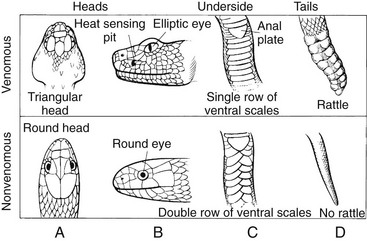Snake and Other Reptile Bites
Definitions and Characteristics
Two main families of venomous snakes indigenous to the United States are Crotalidae (pit vipers) and Elapidae (coral snakes). Most snakebites are caused by the pit vipers, so called because of a depression, or pit, in the maxillary bone. Rattlesnakes (see Plate 7), the cottonmouth (water moccasin) snake (see Plate 8), and the copperhead snake (see Plate 9) are members of the pit viper family. The major snakes of medical importance outside of North America are the cobras, mambas, kraits, coral snakes, Australian elapids, sea snakes, vipers, rattlesnakes, asps, and colubrids (rear-fanged snakes). The fastest pit viper can crawl at a maximum speed of approximately 4.8 km/hr (3 mph). The speed of a pit viper’s strike has been clocked at 2.4 m/sec (8 ft/sec); the snake can reach distances of approximately one-half its body length.
Identifying characteristics of pit vipers include the following (Fig. 37-1):
1. Depression, or pit, in the maxillary bone, located midway between and below the level of the eye and the nostril on each side of the head
2. Vertical elliptic pupils (“cat’s eye”)
3. Triangular head that is distinct from the remainder of the body
4. Single row of subcaudal scutes, or scales
Two members of the coral snake family, Elapidae, are found in the United States: the western coral snake (Micruroides euryxanthus) (see Plate 10), found in Arizona and New Mexico, and the eastern coral snake (Micrurus fulvius) (see Plate 11), distributed from coastal North Carolina through the Gulf states to western Texas. The elapids differ from pit vipers in having very short fangs, round pupils, and subcaudal scales in a double row. Because many nonpoisonous mimics occur in coral snake territory, the rule of thumb for identifying a venomous species is that red bands bordered by yellow or white indicate a venomous reptile, whereas red bands bordered by black indicate a nonvenomous reptile. This rule applies to all coral snakes native to the United States but does not apply to species found south of Mexico City and in other non-U.S. countries. A few essentially harmless, rear-fanged colubrid snakes in the United States, such as the night snake and lyre snake, possess elliptic pupils but lack facial pits.
Pit Viper Envenomation
Signs and Symptoms
1. Common: local burning pain immediately after the bite, weakness, nausea and vomiting, paresthesias, pain, fang marks, swelling and edema (usually within 5 minutes), faintness, dizziness
2. Less common: ecchymosis, fasciculations, hypotension, bullae, necrosis, thirst, increased salivation, unconsciousness, blurred vision, increased respiratory rate
a. May have rapidly progressing edema that can involve an entire extremity within 1 hour if envenomation is severe (Table 37-1)
Table 37-1
| ENVENOMATION | CHARACTERISTICS |
| None | Fang marks, but no local or systemic reactions |
| Minimal | Fang marks, local swelling and pain, but no systemic reactions |
| Moderate | Fang marks and swelling progressing beyond the site of the bite; systemic signs and symptoms such as nausea, vomiting, paresthesias, or hypotension |
| Severe | Fang marks present with marked swelling of the extremity, subcutaneous ecchymosis, severe symptoms including manifestations of coagulopathy |
b. Usually spreads more slowly, over 6 to 12 hours
c. Edema that is soft, pitting, and limited to subcutaneous tissues
4. Hemorrhagic blebs and bullae developing at the site of the bite within hours to days.
5. Paresthesias of the scalp, face, and lips, along with periorbital muscle fasciculations, indicating that a significant envenomation has occurred
6. Hemorrhage manifested as skin petechiae, epistaxis, hematemesis, melena, hemoptysis, and blindness; pulmonary edema possible
7. With some Mohave Desert rattlesnakes, bites produce neuromuscular blockade, leading to respiratory paralysis, in the absence of a significant local tissue reaction. Paralysis initially appears as cranial nerve deficits (hoarseness, difficulty swallowing, ptosis) and progresses to involve the diaphragm.
Treatment
1. Direct treatment at reducing venom effects, minimizing tissue damage, and preventing complicated sequelae.
2. Provide out-of-hospital management.
a. Avoid panic. Instruct the patient to back out of the snake’s striking range, which is approximately the length of the snake.
b. Attempts to secure or kill the snake are not recommended because of the risk for additional bites to the patient or rescuer and because precious time can be lost. Absolute identification of the snake is not necessary for treatment. However, if the snake has been killed and plans are made to transport it, do not handle it directly; arrange to transport it in a closed container. Handle the snake using a stick that is longer than the snake. A severed snake head may envenom for 20 to 60 minutes after decapitation. If a photograph of a snake can be taken from a safe distance, this can be used for identification.
c. Immobilize the bitten extremity by splinting as if for a fracture. Keep the limb well padded at heart level (neither elevated nor lowered) in a position of function. Measure the bitten limb’s circumference at two or more sites every 15 minutes, and mark areas of redness and swelling with a pen.
d. Obtain medical assistance. Arrange for the patient to be transported to the nearest medical facility, with minimal exertion.
e. Encourage the patient to drink liquids to maintain adequate hydration.
f. Treat pain (IV, IM, or SC opioids preferred if available)
g. Remove any tight clothing or jewelry from involved extremities, and anticipate swelling.







